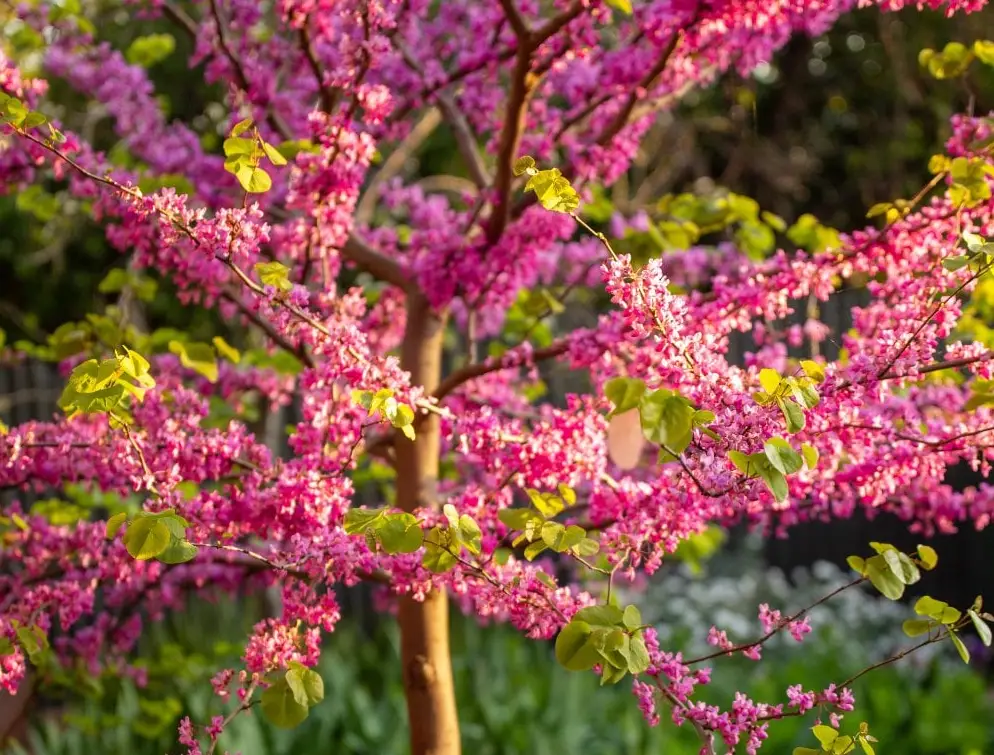The Rising Sun Redbud (Cercis canadensis) is a stunningly beautiful deciduous tree cherished by gardeners and landscapers for its captivating foliage and vibrant seasonal colors. Known for its heart-shaped leaves that transition from golden-orange to lime-green and finally to deep green, the Rising Sun Redbud is truly a showstopper.
This care and growing guide will walk you through all the details needed to ensure your Rising Sun Redbud tree flourishes, including watering, fertilization, pruning, pest control, and more. Let’s dive into how to make your Rising Sun Redbud thrive in any garden!
Understanding the Rising Sun Redbud

The Rising Sun Redbud is a variety of Eastern Redbud tree, native to North America. This compact, ornamental tree is ideal for small gardens and urban landscapes. It’s known for producing vibrant, pea-like pink blooms in early spring before the leaves emerge, which provides a stunning contrast to the tree’s unique foliage.
For optimal growth, it’s essential to plant the Rising Sun Redbud within the appropriate USDA hardiness zones. This tree thrives best in USDA zones 5-9, where it can enjoy the right balance of seasonal temperatures and moisture levels. In these zones, the Rising Sun Redbud is well-suited to handle winter chills without suffering frost damage, while also tolerating the summer heat, especially when placed in partial shade.
Selecting the Right Location
To successfully grow a Rising Sun Redbud, choosing the right location is critical. Here’s what you need to know about selecting the perfect spot for your tree:
Sunlight Requirements
The Rising Sun Redbud thrives in full sun to partial shade. Ideally, the tree should receive at least 4-6 hours of direct sunlight daily. More sunlight will enhance its colorful leaves, while too much shade may result in dull foliage.
Soil Requirements
This tree prefers well-drained, moist, and fertile soil. A slightly acidic to neutral pH level (6.0–7.5) is ideal for optimum growth. If your garden soil is heavy clay, consider amending it with organic matter or sand to improve drainage, as waterlogged roots can harm the tree’s health.
Shelter from Harsh Wind
Though the Rising Sun Redbud is hardy, it benefits from some protection from harsh winds, which can damage its delicate foliage and branches. Planting it near buildings or in sheltered areas is recommended.
Planting the Rising Sun Redbud
Once you’ve selected the perfect location, it’s time to plant your Rising Sun Redbud. Follow these steps to ensure successful establishment.
When to Plant
The best time to plant a Rising Sun Redbud is during early spring or fall when temperatures are cooler and moisture levels are higher. This helps the tree establish its roots before experiencing summer heat or winter cold.
Digging the Hole
Dig a hole that is twice as wide and just as deep as the tree’s root ball. A wider hole will allow the roots to expand easily and establish faster. Loosen the soil at the bottom and sides to facilitate root growth.
Placing the Tree
Place the Rising Sun Redbud in the hole, ensuring that the top of the root ball is level with the soil surface. Backfill the hole with a mix of native soil and organic matter, gently firming it around the roots to eliminate air pockets.
Watering and Mulching
Water the tree thoroughly after planting, then add a 2-3 inch layer of organic mulch around the base, avoiding direct contact with the trunk. Mulch helps retain soil moisture, reduces weed competition, and regulates soil temperature.
Watering the Rising Sun Redbud
Proper watering is key to the healthy growth of the Rising Sun Redbud. Although drought-tolerant once established, this tree needs regular watering during its first few years.
Watering Frequency
During the growing season (spring to fall), water young Rising Sun Redbud trees once a week or when the top 1-2 inches of soil feel dry. Mature trees need less frequent watering but may benefit from additional moisture during prolonged dry periods.
Watering Technique
Use a slow, deep watering method to allow moisture to penetrate the soil and reach the root zone. Avoid shallow watering, as it encourages surface root growth rather than deep, stable roots.
Fertilizing the Rising Sun Redbud
Fertilization provides essential nutrients to encourage healthy growth and vibrant foliage in your Rising Sun Redbud.
When to Fertilize
Fertilize the tree once in early spring before new growth appears. An annual feeding should be enough for established trees, while younger trees may benefit from an additional feeding in mid-summer.
Type of Fertilizer
Use a balanced, slow-release fertilizer with an N-P-K ratio of 10-10-10. Alternatively, you can use a fertilizer formulated specifically for flowering trees to promote blooms and strong foliage.
Application Method
Apply the fertilizer around the tree’s drip line, avoiding direct contact with the trunk. Water the area thoroughly after applying fertilizer to help it penetrate the soil.
Pruning and Shaping
Pruning is important for maintaining the Rising Sun Redbud’s shape and size and for removing damaged or diseased branches.
Best Time to Prune
Prune the Rising Sun Redbud in late winter or early spring before new growth begins. Avoid pruning in fall, as this can stimulate new growth susceptible to winter damage.
Pruning Techniques
- Remove Deadwood: Cut away any dead, damaged, or diseased branches to improve air circulation and reduce the risk of disease.
- Shape the Tree: Lightly shape the tree to maintain its natural, open form, but avoid heavy pruning, which can stress the tree.
Avoid Over-Pruning
Over-pruning can weaken the Rising Sun Redbud, affecting its overall health and vigor. Always prune conservatively to keep the tree healthy.
Common Pests and Diseases
The Rising Sun Redbud is relatively hardy, but it can be vulnerable to certain pests and diseases.
Pests
- Aphids: These small insects feed on the tree’s sap and can cause leaf curling or yellowing. Use insecticidal soap or neem oil to control aphid infestations.
- Caterpillars: Caterpillars may feed on the foliage, leading to defoliation. Handpick caterpillars or use natural predators like ladybugs.
Diseases
- Verticillium Wilt: This soil-borne disease causes leaves to wilt and branches to die back. Prevent verticillium wilt by planting in well-drained soil and removing infected branches promptly.
- Leaf Spot: Fungal leaf spot diseases can cause brown or black spots on leaves. Remove affected leaves and ensure proper air circulation around the tree.
Seasonal Care Tips
Proper seasonal care is key to the Rising Sun Redbud’s health and beauty.
Spring
- Apply fertilizer and prune as needed.
- Check for signs of new growth and monitor for pests.
Summer
- Water consistently and deeply.
- Mulch to retain moisture and keep the soil cool.
Fall
- Limit watering as temperatures cool.
- Rake fallen leaves to reduce disease risk.
Winter
- Protect young trees from frost with burlap wraps.
- Water sparingly to prevent root rot.
Growing Rising Sun Redbud in Containers
For gardeners with limited space, the Rising Sun Redbud can thrive in containers. Choose a large pot with good drainage holes and use a high-quality potting mix. Place the container in a sunny location and water regularly, as containerized trees dry out faster than ground-planted trees.
Benefits of Growing Rising Sun Redbud
Growing a Rising Sun Redbud has many benefits:
- Pollinator Attractor: The pink blooms attract bees, butterflies, and other pollinators.
- Seasonal Interest: With color-changing leaves, the tree adds interest to gardens year-round.
- Low Maintenance: This tree requires minimal upkeep once established.
Conclusion
The Rising Sun Redbud is a striking addition to any landscape, offering a spectrum of colors throughout the seasons and attracting beneficial pollinators. By following this comprehensive care and growing guide, your Rising Sun Redbud will thrive, enhancing your garden’s beauty with minimal maintenance. Remember to plant in well-draining soil, water consistently, and provide seasonal care to keep your tree healthy and vibrant.
For garden lovers and landscapers, the Rising Sun Redbud represents a harmonious blend of beauty, resilience, and ease, making it an outstanding choice for creating a captivating outdoor space.






